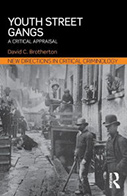Youth Street Gangs: A Critical Appraisal

Author: David C. Brotherton
Publisher: London; New York: Routledge, 2015. 228p.
Reviewer: Robert J. Durán | May 2016
In Youth Street Gangs, David Brotherton provides a concise yet critical overview of the gang literature, while at the same time providing recommendations for how researchers, both new and experienced, can broaden their understanding of street organizations. Few gang researchers possess a similar breadth of knowledge of gangs by years of attention (more than 20 years), geographic comparison (Barcelona, London, New York City, Quito, San Francisco, and Santo Domingo), and direct interaction with gang members of various backgrounds. Collaboratively, Brotherton seeks to highlight other existing counter narratives in the gang literature toward this overall call for researchers to develop a more critical examination of street organizations. In this review, I will provide an overview of three key themes presented in the book’s seven chapters, in order to outline why I think this book is essential reading for the study of gangs.
The first contribution of Youth Street Gangs is the importance of thinking critically both methodologically and theoretically. The author begins by citing the work of Jock Young (2011: 28) who emphasized “…every researcher has a gaze they bring to their studies.” Despite orthodox criminology claiming neutrality, that reality is presumed to be impossible. A critical theorist identifies the theory they prefer and reflexively outlines how it developed from an individual’s background. For Brotherton — growing up in the 1960s in an East London marginalized community and belonging to stigmatized working-class groups (skinheads and soccer hooligans) — created a different vantage point for understanding gangs. Thus, when he moved to the United States to begin his doctoral education in California, he was already curious to ask different questions, despite being an outsider. The methodological training he received emphasized Howard Becker’s notion of getting closer to the natural habitat, rather than studying things from afar — the importance of direct, first hand observation. The goal is to understand gangs through the eyes of the participants while constantly remaining reflexive regarding how researchers are positioned and situated. Brotherton advises researchers to remove themselves from the center, and to situate oneself on the periphery to observe and listen. He is concerned with researchers encountering a neoliberal dominated framework that determines what research can be published and what types of research can receive funding. Such a hegemonic version of gangs, focused on pathologizing the “Other” and demanding increased punishment, tends to dominate the current global discourse.
The second contribution Brotherton offers in Youth Street Gangs is his analysis of the existing literature within a historical framework. He encourages a “history from below” that places the study of gangs in time and seeks to understand changes occurring in specific gangs. He groups the study of gangs into four theoretical clusters: Chicago School, sociological humanism, Hobbesian, and social reproductionism. The Chicago School’s influence can be found in the work of Frederic Thrasher, who provided a humanistic approach to the study of gangs that was not fixated on alcohol, drugs, and violence. However, Thrasher’s work encountered ideological blind spots that that did not allow for an analysis of structural forces. Sociological humanism brought to light the contradictions between agency and structure and how adaptive subcultures could form in society. Brotherton considers sociological humanism’s emphasis on theory as a high point for gang studies. His sharpest critiques are focused on what he describes as the Hobbesian alternative that has largely pathologized gangs and reduced individuals to a deficit model. In this mindset, gang members are lacking in social control. This theoretical cluster does not consider the contradictions of middle class society, nor question the supremacy of the United States or the need to generalize. This dominant discourse links with a broader neoliberal model that focuses on positivism, increasing the distance between the researcher and the researched, and adopts the ideologies of the state.
The final theoretical cluster outlined by Brotherton — social reproductionism — has primarily developed since the 1980s, and has focused upon gangs as typological constructs and as post-industrial organizations; it examines gangs as quasi-institutions. In outlining this study of gangs, the author pushes readers to move towards a critical gang theory, which he calls “situated resistance.” Such a theory pushes individuals to develop working concepts of resistance and agency in the study of situated spaces, situated cultures, situated politics, situated crime and violence, situated organizations, and situated societal responses.
The third key theme here is an outline of existing gaps in the study of street organizations and the importance of using research for social reform, self-empowerment, and social justice. Brotherton outlines methodological and theoretical gaps in the literature. Theoretically, he pushes researchers to consider cultural criminology, and the appendix of Youth Street Gangs provides a thorough dialogue between David Brotherton and Jock Young on such a perspective.
The author outlines the steps for studying gangs critically. This includes five foci for correcting the most glaring omissions in gang research. These are much needed and stand in stark contrast to gang researchers who remain infatuated with determining levels of criminal offending, while other issues remain empirically ignored in the lived experiences of gang-involved individuals. Thus, in a society of unequal power relations, the quest for self-knowledge is all the more critically important when we live in a time frame in which gangs have become powerful indicators of the contradictions in the larger society, or in Brotherton’s words “…a last refuge in the age of neo-liberalism.” (p.130).
Young, Jock. 2011. The Criminological Imagination. London: Polity.
Robert J. Durán is an Assistant Professor of Sociology at the University of Tennessee.


